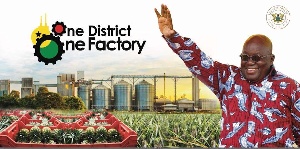 1D1F is to ignite Ghana's industrialisation and its socio-economic development.
1D1F is to ignite Ghana's industrialisation and its socio-economic development.
Despite the country’s economy growing by 8.5 percent in 2017 – largely boosted by oil and gas – one of the critical sectors, manufacturing, sadly continues its poor showing.
The provisional 2017 GDP figures released by the Ghana Statistical Service (GSS) shows that the manufacturing subsector grew by 3.7 percent in the year under review; whereas mining and quarrying, oil and gas which all fall under the industrial sub-sector grew by 46.7 and 80.4 percent respectively.
The figures are even more disappointing when compared on quarterly basis. The manufacturing subsector grew at a measly 1.3 percent in Q4 of 2017; down from 6.2 and 2.5 percent in Q2 and Q3 respectively.
During the same period, mining and quarrying grew by 80.3, 41.2, and 43.9 in Q2, Q3, and Q4 respectively; oil and gas also grew, by 199.7, 72.1 and 57.9 percent in Q2, Q3, and Q4 respectively.
The disappointing performance of the labour-intensive manufacturing sector creates a worrying picture for the economy, especially at a time when youth unemployment remains high.
It is estimated that annually close to 70,000 students graduate from tertiary institutions across the country. However, data from the Institute of Statistics, Social and Economic Research (ISSER) of the University of Ghana has revealed that only 10 percent of graduates find jobs after their first year of completing school.
To address this situation, government took some steps in 2017 to encourage firms and boost productivity in the industrial sector.
Notable among them is the scrapping and/or abolishing some 15 taxes it referred to as ‘nuisance taxes’.
Government has again introduced a programme dubbed the ‘10-point agenda for industrial transformation’. This includes the establishment of industrial parks and special economic zones in all ten regions of Ghana.
Others include the establishment of an industrial sub-contracting expo that will link a certain need of supply chains for large-scale enterprises, promote export diversification with particular emphasis on non-traditional exports, improve domestic retail trade, and promote domestically manufactured goods (i.e. Made in Ghana goods).
Again, government plans to use the ‘One District, One Factory’ (1D1F) project to revive the manufacturing sector and promote agro-processing in the country.
However, since launch of the programme last year, progress on its implementation has been slow.
Financial analyst and Managing Director of Dalex Finance, Ken Thompson, earlier this month said the 1D1F programme risks failing due to what he calls the ‘overvalued’ local currency.
He argues that the cedi’s overvaluation makes imports cheaper and exports uncompetitive, and puts a constraint on economic growth – and could actually stifle government’s own ‘One District, One Factory’ initiative.
“With an over-valued currency, even if these factories commence production, cheaper imports will make their goods uncompetitive locally; and even if they are exported, the gains will not be as much as expected.
“As long as the cedi is overvalued, all the proposed industries – including the ‘One District, One Factory’ initiative – will be at a potent risk of failure,” he said.
Mr. Thompson further posits that the distress faced by the manufacturing sector is as a result of cheap imports – hence, the cedi should be devalued.
“Our manufacturing sector is crumbling due to cheap imports. And the manufacturers resilient enough to continue producing are finding it difficult to market locally or export. Should the cedi be devalued, exporters will be the biggest beneficiaries – and they will be able to expand, create jobs and expand the economy.
“The cedi needs to be devalued, then we can confidently say the One District, One Factory programme can be sustained over the long-term. Why do you think a major economic player such as China intentionally devalued its currency? It was boosting exports,” he argued.